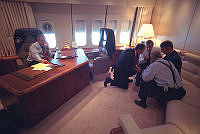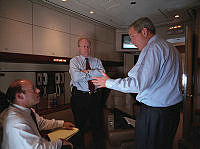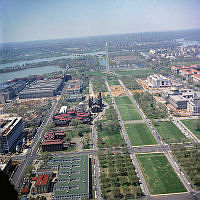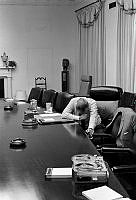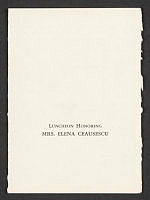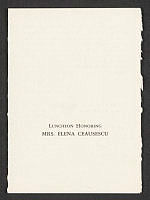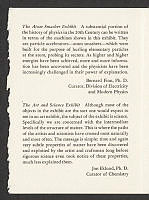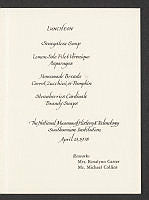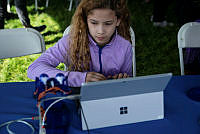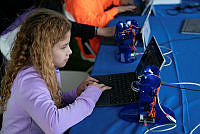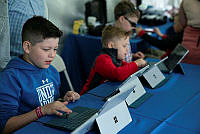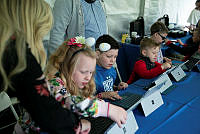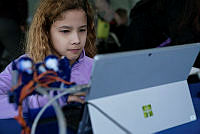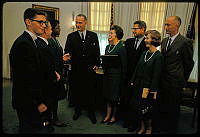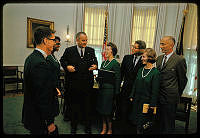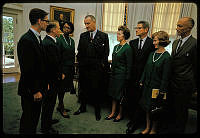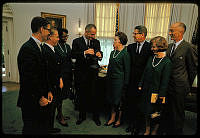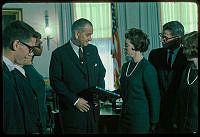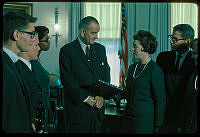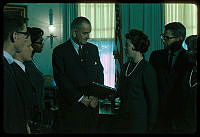Rubenstein Center Scholarship
White House Technology Timeline
1790s
Inventories of the tools in the stonecutting sheds suggest that some of the stone was sawed, a technique that bypassed usual tooling used to "finish" the stone's surface. The cut resulted in two stones, each with a smooth face. Read More
1800s
President Thomas Jefferson gave orders for the demolition of the outdoor wooden privy and had two water closets installed upstairs, one on each end of the house. He also had a wine cellar built just west of the house and called it an "ice house." Read More
1810s
Considering that it had initially taken nearly ten years to build the White House, it was remarkable that James Hoban was able to direct a reconstruction of the house (after the British torched the house in 1814) in slightly less than three years. Read More
1820s
President John Quincy Adams was an avid gardener who expanded the White House garden to two acres. An iron garden pump with "nine spout holes" was attached to a well at the Treasury building and provided water for the grounds. Read More
1830s
Running water was introduced into the White House in 1833. Initially its purpose was to supply the house with drinking water and to fill reservoirs for protection against fire. Read More
1840s
Installation of a gravity hot-air heating system began in the spring of 1840. The system used a self-contained furnace with an inner firebox of iron enclosed by a shell of plastered brick where the air was warmed. Read More
1850s
The 1850s saw many improvements and expansions to the mansion's existing conveniences. By this time many Americans who had gaslight wondered how they had ever lived without it. Read More
1860s
The second floor quarters occupied by President Abraham Lincoln and his family were used much as they had been during the 1850s. Read More
1870s
Social functions at the Ulysses S. Grant White House attracted so many visitors that the Red, Blue and Green parlors became extremely hot and stuffy. Read More
1880s
On February 12, 1880, a wooden crate arrived at the White House containing a new contrivance which would make a more immediate difference than the telephone: a Fairbanks & Company Improved Number Two Typewriter. Read More
1890s
Electric lighting was installed in the White House in 1891. Few people at the time had enough faith in electric lighting to use it exclusively-its use was barely a decade old. Read More
1900s
By the time Theodore Roosevelt took office, the use of electric light was common in American houses. The entire wiring system was replaced during a major restoration of the White House in 1902. Read More
1910s
First Lady Helen Taft loved entertaining and White House hospitality during the William Howard Taft administration centered on the dining table, where the Tafts' tastes were regal. A "Forty-quart Peerless Ice Cream Freezer," with a direct current motor and a twelve-foot long Imperial French Coal Range were added to the large kitchen in 1912. Read More
1920s
By the 1920s electric vacuum cleaners were cleaning the White House carpets, and an electric refrigerator was humming in the kitchen. Read More
1930s
Reconstruction of the West Wing in 1930 after extensive damage by a Christmas Eve fire in 1929 included a central air-conditioning system installed by Carrier Engineering Company. Read More
1940s
When the United States entered World War II in December 1941, White House security became a much more serious concern than it had been in the past. Read More
1950s
In 1952, following a major renovation of the White House, President Harry S. Truman invited ABC, NBC, and CBS, to bring their cameras and correspondents to the White House to accompany the president on a tour of the reconstructed White House. Read More
1960s
On July 20, 1969, President Richard M. Nixon spoke from the White House by radiotelephone with Apollo 11 astronauts Neil Armstrong and Edwin E. "Buzz" Aldrin. Read More
1970s
In response to the economic crisis created by the Arab oil embargo and the nation's growing dependence on foreign oil, President Jimmy Carter called for a comprehensive campaign to conserve energy. Read More
1980s
The Jimmy Carter administration began the task of automating the White House with computers. Initial uses included assembling databases, tracking correspondence, developing a press release system, and compiling issues and concerns of Congress. Read More
1990s
E-mail was introduced to the White House in 1992. President George H.W. Bush became the first president to use this new technology. Read More
2000s
The National Park Service oversaw the installation of three solar energy systems on the White House grounds in 2002. Read More




